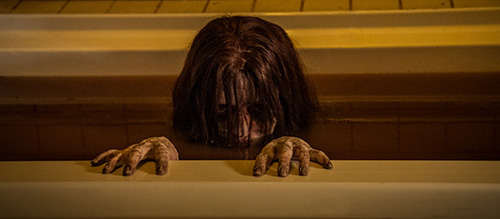The Grudge (2020) Review
The Grudge (2020)
Director: Nicolas Pesce
Screenwriter: Nicolas Pesce
Starring: Andrea Riseborough, Demian Bichir, John Cho, Betty Gilpin, Lin Shaye, Jacki Weaver
At a New York Comic Con panel, director Nicolas Pesce described his Grudge film as having a “deeper, human character narrative”. A character driven narrative focuses on the internal conflict characters in the story face, showing an evolution in their outlook, decision making and relationships.
Of course, The Grudge is horror. Its primary purpose is to externalize inner demons, creating a malicious corporealization of fear, anxiety and/or guilt. Its strength should lie in its ability to effectively communicate those characterizations and comport them to the external threat in a way that frightens the audience.
So why do we have three different families with completely separate problems getting spooked by a little girl?
The film first introduces us to Detective Muldoon, a cop who lost her husband to cancer three months prior to the film’s beginning (thanks to Officer Exposition for telling us that). She tells her kid that nothing bad is ever going to happen to them, and establishes a cutesy method of coping with fear by closing their eyes and counting to five. At what seems to be her first day at a new job, she is taken to the site of a fatal car wreck that happened about a year ago but was just discovered for reasons I don’t remember because they seemed super random at the time of mentioning. Apparently the driver was “that assisted suicide lady”, and it reminds Muldoon’s partner of the case at the old Landers house. He won’t discuss the case, and turns the investigation over to the feds. Naturally, Muldoon visits the old Landers house, gets spooked by some old people that may or may not be dead, and starts… investigating? It’s not clear what she’s doing, or why. Is she just reading old case files for fun? Does she not have other police work to be doing? Did she not have that first day of filling out paperwork for HR? She is at least skeptical when her partner tells her about his old partner that thought the house had “bad energy”, but it’s not a convincing denial.
Then the timeline jump starts. We don’t really get to know the Landers family, but their real estate agent starts poking around their property to get signatures for the house’s sale. He and his wife are having a baby, but it might have ALD (which is a deadly genetic disease that essentially destroys your brain, though the movie never mentions that). They dance around the “should we abort the baby” discussion (although the choice is ultimately the woman’s alone – good on you, movie), and most of this storyline is spent with John Cho on a couch with the dead child of the dead homeowners.
Finally, the film reintroduces the “assisted suicide lady” through the Matheson family. Lin Shaye gives the best performance in the film as crazy old Mrs. Matheson, and her husband wants the assisted suicide lady to help his wife end her life with dignity. Another opportunity for actual discussion of the ethics of a difficult decision people in life face is squandered, and we are instead treated to scenes of an old lady talking to ghosts.
None of these characters really change, mostly because there isn’t enough time for them to. We’re shown their stories like an anthology on shuffle, covering three different years over a span of mere days within those years. There is nothing ultimately connecting these storylines together. There’s a thematic throughline regarding the death (or potential death) of a loved one, but it’s hardly explored. Why these people? Because they walked into this fancy craftsman home that 90% of horror films in the last ten years take place in. Their pain, tragedy, and suffering are backdrops for the curse brought on by a murder that took place in Japan that isn’t in this movie and is entirely unrelated to them. When the demon (which isn’t a demon) has nothing to do with these particular individuals outside of their physical location, and the intention of creating a work focused on character doesn’t line up with what’s presented, there can’t be a character-driven narrative when no character is given time to do anything meaningful beyond getting spooked by beings that do have physical bodies. It’s impossible to tell where along the line the film lost its way, but the most obvious aspects of the script hint towards pre-production issues (as opposed to something mangled in editing due to corporate meddling).
All that being said, there are some effective filmmaking techniques in the film. Drawn out “looking around a room in the dark” sequences are scoreless (save the occasional and brief sweeping synth). Instead, the sound design features heavy breathing and creaking floors that build the anticipation. It’s eerie, especially when we’ve grown so accustomed to scary strings. The darkness of shots feels natural, and impedes the ability to feel safe since even the protagonists aren’t completely in our vision. The makeup and design on the dead or dying is solid, especially things like decaying or scarred flesh.
Using multiple families to tell the story leads to the story failing to achieve its overall goal of a character driven narrative. There’s no one for the audience to latch onto for the entirety of the story, no one that stands out as a particularly good character, and nothing interesting enough to warrant resurrecting a franchise over making something original. This isn’t Hereditary or Get Out, it’s just a remake of The Grudge for a world whose aesthetic sensibilities in horror have been shaped by post-Saw James Wan.
11/24


